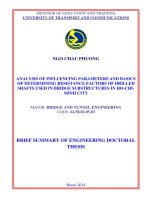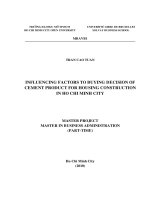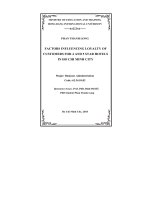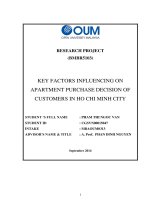SUBJECT APPLIED ECONOMETRICS TOPIC factors influencing undergraduates’sleep in ho chi minh city
Bạn đang xem bản rút gọn của tài liệu. Xem và tải ngay bản đầy đủ của tài liệu tại đây (358.96 KB, 54 trang )
UEH UNIVERSITY
COLLEGE OF ECONOMICS, LAW AND GOVERNMENT
DEPARTMENT OF ECONOMICS
FINAL RESEARCH REPORT
SUBJECT: APPLIED ECONOMETRICS
TOPIC: Factors influencing undergraduates’sleep in Ho Chi
Minh City
Instructor: Nguyễn Quang
Term Code: 22C1ECO50106704
Group: 6 – Classes: IVC03+VAC01
TP Hồ Chí Minh, 11/11/2022
0
TIEU LUAN MOI download : moi nhat
MEMBERS
GROUP 6
NUMBER
FULL NAME
STUDENT ID
1
2
Nguyễn Huy Hoàng
Nguyễn Bảo Nhã Phương
31211021593
31211024620
PERCENT OF
COMPLETION
100%
100%
3
4
5
Nguyễn Thị Thảo
Nguyễn Lê Thi Thi
Nguyễn Hoàng Phúc Thiện
31211022646
31211025378
31211025008
100%
100%
100%
6
Trần Thanh Trúc
31211026391
100%
7
8
Trịnh Bích Tuyền
Nguyễn Trần Hồng Yến
31211025881
31211026115
100%
100%
1
TIEU LUAN MOI download : moi nhat
SUBJECT.APPLIED.ECONOMETRICS.TOPIC.factors.influencing.undergraduates’sleep.in.ho.chi.minh.citySUBJECT.APPLIED.ECONOMETRICS.TOPIC.factors.influencing.undergraduates’sleep.in.ho.chi.minh.citySUBJECT.APPLIED.ECONOMETRICS.TOPIC.factors.influencing.undergraduates’sleep.in.ho.chi.minh.citySUBJECT.APPLIED.ECONOMETRICS.TOPIC.factors.influencing.undergraduates’sleep.in.ho.chi.minh.citySUBJECT.APPLIED.ECONOMETRICS.TOPIC.factors.influencing.undergraduates’sleep.in.ho.chi.minh.citySUBJECT.APPLIED.ECONOMETRICS.TOPIC.factors.influencing.undergraduates’sleep.in.ho.chi.minh.citySUBJECT.APPLIED.ECONOMETRICS.TOPIC.factors.influencing.undergraduates’sleep.in.ho.chi.minh.citySUBJECT.APPLIED.ECONOMETRICS.TOPIC.factors.influencing.undergraduates’sleep.in.ho.chi.minh.city
SUBJECT.APPLIED.ECONOMETRICS.TOPIC.factors.influencing.undergraduates’sleep.in.ho.chi.minh.citySUBJECT.APPLIED.ECONOMETRICS.TOPIC.factors.influencing.undergraduates’sleep.in.ho.chi.minh.citySUBJECT.APPLIED.ECONOMETRICS.TOPIC.factors.influencing.undergraduates’sleep.in.ho.chi.minh.citySUBJECT.APPLIED.ECONOMETRICS.TOPIC.factors.influencing.undergraduates’sleep.in.ho.chi.minh.citySUBJECT.APPLIED.ECONOMETRICS.TOPIC.factors.influencing.undergraduates’sleep.in.ho.chi.minh.citySUBJECT.APPLIED.ECONOMETRICS.TOPIC.factors.influencing.undergraduates’sleep.in.ho.chi.minh.citySUBJECT.APPLIED.ECONOMETRICS.TOPIC.factors.influencing.undergraduates’sleep.in.ho.chi.minh.citySUBJECT.APPLIED.ECONOMETRICS.TOPIC.factors.influencing.undergraduates’sleep.in.ho.chi.minh.city
ABSTRACT:
This study estimates and examines the factors affecting the sleep of students in Ho
Chi Minh City, expressed in the number of hours of bedtime per night of students, can
draw conclusions and reinforce the reader's understanding of the importance of sleep.
The results showed that those who had a lot of study time had fewer hours of bedtime.
The time of commuting to work in a student's day or leisure time such as surfing the
web, watching movies also negatively affects the number of hours of bedtime. From the
results, students can arrange their study, part-time and leisure time accordingly to be
able to both complete work and ensure health.
Keywords: sleep, students, health, study, entertainment
2
TIEU LUAN MOI download : moi nhat
SUBJECT.APPLIED.ECONOMETRICS.TOPIC.factors.influencing.undergraduates’sleep.in.ho.chi.minh.citySUBJECT.APPLIED.ECONOMETRICS.TOPIC.factors.influencing.undergraduates’sleep.in.ho.chi.minh.citySUBJECT.APPLIED.ECONOMETRICS.TOPIC.factors.influencing.undergraduates’sleep.in.ho.chi.minh.citySUBJECT.APPLIED.ECONOMETRICS.TOPIC.factors.influencing.undergraduates’sleep.in.ho.chi.minh.citySUBJECT.APPLIED.ECONOMETRICS.TOPIC.factors.influencing.undergraduates’sleep.in.ho.chi.minh.citySUBJECT.APPLIED.ECONOMETRICS.TOPIC.factors.influencing.undergraduates’sleep.in.ho.chi.minh.citySUBJECT.APPLIED.ECONOMETRICS.TOPIC.factors.influencing.undergraduates’sleep.in.ho.chi.minh.citySUBJECT.APPLIED.ECONOMETRICS.TOPIC.factors.influencing.undergraduates’sleep.in.ho.chi.minh.city
SUBJECT.APPLIED.ECONOMETRICS.TOPIC.factors.influencing.undergraduates’sleep.in.ho.chi.minh.citySUBJECT.APPLIED.ECONOMETRICS.TOPIC.factors.influencing.undergraduates’sleep.in.ho.chi.minh.citySUBJECT.APPLIED.ECONOMETRICS.TOPIC.factors.influencing.undergraduates’sleep.in.ho.chi.minh.citySUBJECT.APPLIED.ECONOMETRICS.TOPIC.factors.influencing.undergraduates’sleep.in.ho.chi.minh.citySUBJECT.APPLIED.ECONOMETRICS.TOPIC.factors.influencing.undergraduates’sleep.in.ho.chi.minh.citySUBJECT.APPLIED.ECONOMETRICS.TOPIC.factors.influencing.undergraduates’sleep.in.ho.chi.minh.citySUBJECT.APPLIED.ECONOMETRICS.TOPIC.factors.influencing.undergraduates’sleep.in.ho.chi.minh.citySUBJECT.APPLIED.ECONOMETRICS.TOPIC.factors.influencing.undergraduates’sleep.in.ho.chi.minh.city
TABLE OF CONTENTS
CHAPTER I: INTRODUCE......................................................................................4
1. Significance of the Study:....................................................................................4
2. Purpose of research:............................................................................................4
3. Subjects, scope, survey units...............................................................................5
CHAPTER II: THEORY OVERVIEW....................................................................5
1. Related Concepts:.............................................................................................5
2. Body functions and activities during sleep:.....................................................5
3. Factors affecting sleep:........................................................................................6
CHAPTER III: RESEARCH METHODS................................................................6
1.Sampling method:.................................................................................................6
2.Research process:..................................................................................................7
3.Survey questions:..................................................................................................7
4.Analysis results:....................................................................................................8
5.Quantitative and qualitative research results:....................................................8
6.Research scale:......................................................................................................8
7. Suggested model:.................................................................................................9
7.1. Model and variables in the model:...............................................................9
7.2. Comments on the variables in the model:..................................................12
CHAPTER IV: RESEARCH RESULTS................................................................17
1. Variable descriptive statistics:..........................................................................17
2. Regression results:..........................................................................................19
3. Multicollinearity test..........................................................................................23
4. Heteroscedasticity test by the Breusch-Pagan test:.........................................23
5. Testing for autocorrelation by Breusch-Godfrey test:....................................24
CHAPTER V: CONCLUSION................................................................................24
1. Conclusion:.........................................................................................................24
2. Limitations of the study:...................................................................................25
3. Some recommendations for future research:...................................................25
REFERENCES...........................................................................................................26
3
TIEU LUAN MOI download : moi nhat
SUBJECT.APPLIED.ECONOMETRICS.TOPIC.factors.influencing.undergraduates’sleep.in.ho.chi.minh.citySUBJECT.APPLIED.ECONOMETRICS.TOPIC.factors.influencing.undergraduates’sleep.in.ho.chi.minh.citySUBJECT.APPLIED.ECONOMETRICS.TOPIC.factors.influencing.undergraduates’sleep.in.ho.chi.minh.citySUBJECT.APPLIED.ECONOMETRICS.TOPIC.factors.influencing.undergraduates’sleep.in.ho.chi.minh.citySUBJECT.APPLIED.ECONOMETRICS.TOPIC.factors.influencing.undergraduates’sleep.in.ho.chi.minh.citySUBJECT.APPLIED.ECONOMETRICS.TOPIC.factors.influencing.undergraduates’sleep.in.ho.chi.minh.citySUBJECT.APPLIED.ECONOMETRICS.TOPIC.factors.influencing.undergraduates’sleep.in.ho.chi.minh.citySUBJECT.APPLIED.ECONOMETRICS.TOPIC.factors.influencing.undergraduates’sleep.in.ho.chi.minh.city
SUBJECT.APPLIED.ECONOMETRICS.TOPIC.factors.influencing.undergraduates’sleep.in.ho.chi.minh.citySUBJECT.APPLIED.ECONOMETRICS.TOPIC.factors.influencing.undergraduates’sleep.in.ho.chi.minh.citySUBJECT.APPLIED.ECONOMETRICS.TOPIC.factors.influencing.undergraduates’sleep.in.ho.chi.minh.citySUBJECT.APPLIED.ECONOMETRICS.TOPIC.factors.influencing.undergraduates’sleep.in.ho.chi.minh.citySUBJECT.APPLIED.ECONOMETRICS.TOPIC.factors.influencing.undergraduates’sleep.in.ho.chi.minh.citySUBJECT.APPLIED.ECONOMETRICS.TOPIC.factors.influencing.undergraduates’sleep.in.ho.chi.minh.citySUBJECT.APPLIED.ECONOMETRICS.TOPIC.factors.influencing.undergraduates’sleep.in.ho.chi.minh.citySUBJECT.APPLIED.ECONOMETRICS.TOPIC.factors.influencing.undergraduates’sleep.in.ho.chi.minh.city
CHAPTER I: INTRODUCE
1. Significance of the Study:
Staying up late has almost become a difficult habit for the majority of young people
today in general and students in particular. The question is, what do students "stay up
late" for? And how often? But for whatever reason, staying up is still an unhealthy habit
and causes a lot of damage to our physical and mental health.
According to statistics, each of us needs to spend up to 36% of our lives sleeping.
This means that if you live to be 70 years old, the sleep time will be more than 25 years.
This intangible generally says that sleep is an important norm in our lives. But now
many websites propagate false ideas about sleep, they attribute sleep as a manifestation
of laziness, wasting time, the less sleep will be more successful,... The truth is, if you
understand your body's sleep and sleep correctly and get enough sleep will enhance
long-term memory as well as better academic productivity.
In 1942, less than 8% of the nightly population slept only 6 hours or less. In 2017,
this number accounted for half. According to the statistics of scientists around the world,
insomnia costs the UK economy more than £30 billion in profits each year, or 2% of
GDP. If you drive after sleeping less than 5 hours, you are 4.3 times more likely to have
an accident. If you drive after sleeping for 4 hours, you are 11.5 times more likely to
have an accident. These horrific numbers show us the consequences of people depriving
themselves of sleep, especially in adolescence.
Ho Chi Minh City has more and more 24-hour cafes such as Three O'clock, Thuc
coffee, OFA coffee,... At 11 pm, just go to these cafes, most of the customers are full,
most of the customers are from 17-30 years old. Each individual here has their own job
such as going with friends, surfing the web, watching movies, playing games, the
remaining few study, read books ..., but it can be seen that staying up late is becoming
more and more common among many people, especially young people and especially
students.
Therefore, it is extremely necessary to study the sleep quality of young people.
Youth have a huge advantage in health wear, but if not maintained and preserved, very
quickly negative effects will appear. But if we are aware of and appreciate sleep early,
we can study and work more efficiently, with a clearer, sharper mind. Stemming from
the above reasons, our group chose the topic "The situation of students staying up late in
Ho Chi Minh City and affecting health" to study.
2. Purpose of research:
- Learn about the current state of students staying up late in HCMC.
- The extent, nature, scale of staying up late.
- Recognize the factors that influence students' staying up late.
- Effects of staying up late on human health and giving advice (positive and negative
influences).
- Propose remedies, give the right advice against the effects of staying up late on
students today.
4
TIEU LUAN MOI download : moi nhat
SUBJECT.APPLIED.ECONOMETRICS.TOPIC.factors.influencing.undergraduates’sleep.in.ho.chi.minh.citySUBJECT.APPLIED.ECONOMETRICS.TOPIC.factors.influencing.undergraduates’sleep.in.ho.chi.minh.citySUBJECT.APPLIED.ECONOMETRICS.TOPIC.factors.influencing.undergraduates’sleep.in.ho.chi.minh.citySUBJECT.APPLIED.ECONOMETRICS.TOPIC.factors.influencing.undergraduates’sleep.in.ho.chi.minh.citySUBJECT.APPLIED.ECONOMETRICS.TOPIC.factors.influencing.undergraduates’sleep.in.ho.chi.minh.citySUBJECT.APPLIED.ECONOMETRICS.TOPIC.factors.influencing.undergraduates’sleep.in.ho.chi.minh.citySUBJECT.APPLIED.ECONOMETRICS.TOPIC.factors.influencing.undergraduates’sleep.in.ho.chi.minh.citySUBJECT.APPLIED.ECONOMETRICS.TOPIC.factors.influencing.undergraduates’sleep.in.ho.chi.minh.city
SUBJECT.APPLIED.ECONOMETRICS.TOPIC.factors.influencing.undergraduates’sleep.in.ho.chi.minh.citySUBJECT.APPLIED.ECONOMETRICS.TOPIC.factors.influencing.undergraduates’sleep.in.ho.chi.minh.citySUBJECT.APPLIED.ECONOMETRICS.TOPIC.factors.influencing.undergraduates’sleep.in.ho.chi.minh.citySUBJECT.APPLIED.ECONOMETRICS.TOPIC.factors.influencing.undergraduates’sleep.in.ho.chi.minh.citySUBJECT.APPLIED.ECONOMETRICS.TOPIC.factors.influencing.undergraduates’sleep.in.ho.chi.minh.citySUBJECT.APPLIED.ECONOMETRICS.TOPIC.factors.influencing.undergraduates’sleep.in.ho.chi.minh.citySUBJECT.APPLIED.ECONOMETRICS.TOPIC.factors.influencing.undergraduates’sleep.in.ho.chi.minh.citySUBJECT.APPLIED.ECONOMETRICS.TOPIC.factors.influencing.undergraduates’sleep.in.ho.chi.minh.city
-
3. Subjects, scope, survey units.
Target audience: All students in HO CHI MINH CITY.
Scope: Ho Chi Minh City.
Survey unit: Group of students of Applied Econometric class.
CHAPTER II: THEORY OVERVIEW
1. Related Concepts:
- Student concept:
Students are those between the ages of 18-25, have graduated from high school and
are enrolled in a program at one (or more) University or College.
- The concept of staying up late:
According to recommendations from the National Organization for Sleep Support
and Self-Assessment, people aged 18-25 (students) require 7-9 hours of sleep per day.
Clinically, 23 hours is the time when the body begins to enter the detoxification and
recovery phase. Therefore, from a biological point of view, if you stay up past 22:30,
you will be considered as staying up late.
Under normal circumstances, 22:30 pm to 6:30 am is the best time to sleep, by
sleeping at the right time, you can ensure that the organs are working at their most stable
state, then the body is in. a healthy biological clock.
2. Body functions and activities during sleep:
"Sleep must serve a very important function, which has led to its persistence
throughout evolution," said Dr David Raizen, an associate professor of neurology at the
University of Pennsylvania in the US. "Sleep time is when the brain and body work a
lot, bringing good effects to health. The body works during sleep through two stages:
+ NREM - non-rapid eye movement stage (accounting for 75-80% of sleep): the
stage when the brain is less responsive to external stimuli. At this stage, the body
enters the process of deep sleep, thinking and functions inside the body show
signs of slowing down, so the process of regeneration and repair of cells inside
the body is carried out at this stage. this.
+ REM - Rapid eye movement (accounting for 20-25% of our sleep) at this stage,
your eyes will move back and forth at the back of the eyelids. The body will fall
into a state of stillness, but your pulse system, internal body temperature,
breathing rate and blood pressure will rise above daytime levels. At this stage,
dreams are somewhat more vivid and more emotional.
Brain Activity: As we fall asleep, our brains experience a pattern of brain waves
known as "spinal rotation," which, according to the Sleep Foundation, we don't fully
understand yet, but are thought to be. “plays a role in learning and integrating new
memories.” The axes of the spine may also play a role in ensuring we stay asleep even
when our brains are exposed to external stimuli. According to a 2019 study in the
journal Science, when we sleep, our brains even wash themselves in a mixture of
5
TIEU LUAN MOI download : moi nhat
SUBJECT.APPLIED.ECONOMETRICS.TOPIC.factors.influencing.undergraduates’sleep.in.ho.chi.minh.citySUBJECT.APPLIED.ECONOMETRICS.TOPIC.factors.influencing.undergraduates’sleep.in.ho.chi.minh.citySUBJECT.APPLIED.ECONOMETRICS.TOPIC.factors.influencing.undergraduates’sleep.in.ho.chi.minh.citySUBJECT.APPLIED.ECONOMETRICS.TOPIC.factors.influencing.undergraduates’sleep.in.ho.chi.minh.citySUBJECT.APPLIED.ECONOMETRICS.TOPIC.factors.influencing.undergraduates’sleep.in.ho.chi.minh.citySUBJECT.APPLIED.ECONOMETRICS.TOPIC.factors.influencing.undergraduates’sleep.in.ho.chi.minh.citySUBJECT.APPLIED.ECONOMETRICS.TOPIC.factors.influencing.undergraduates’sleep.in.ho.chi.minh.citySUBJECT.APPLIED.ECONOMETRICS.TOPIC.factors.influencing.undergraduates’sleep.in.ho.chi.minh.city
SUBJECT.APPLIED.ECONOMETRICS.TOPIC.factors.influencing.undergraduates’sleep.in.ho.chi.minh.citySUBJECT.APPLIED.ECONOMETRICS.TOPIC.factors.influencing.undergraduates’sleep.in.ho.chi.minh.citySUBJECT.APPLIED.ECONOMETRICS.TOPIC.factors.influencing.undergraduates’sleep.in.ho.chi.minh.citySUBJECT.APPLIED.ECONOMETRICS.TOPIC.factors.influencing.undergraduates’sleep.in.ho.chi.minh.citySUBJECT.APPLIED.ECONOMETRICS.TOPIC.factors.influencing.undergraduates’sleep.in.ho.chi.minh.citySUBJECT.APPLIED.ECONOMETRICS.TOPIC.factors.influencing.undergraduates’sleep.in.ho.chi.minh.citySUBJECT.APPLIED.ECONOMETRICS.TOPIC.factors.influencing.undergraduates’sleep.in.ho.chi.minh.citySUBJECT.APPLIED.ECONOMETRICS.TOPIC.factors.influencing.undergraduates’sleep.in.ho.chi.minh.city
cerebrospinal fluid and blood. As the body enters the NREM phase, brain cells also
begin to enter a phase of more regular and rhythmic activity. However, when you begin
to enter REM dreams, brain activity will return to normal, roughly the same as when the
body is in the waking state.
The process of metabolism and detoxification of the body:
+ From 21 to 23h: Is the time when the immune system (lymphocytes) detoxifies
(eliminates toxins), this time is quiet or listening to relaxing music.
+ From 23h to 3h: This is the time when Gallbladder and Liver detox and dispose
of waste, which should be carried out while asleep; During this time, you should
sleep well to avoid kidney diseases. In addition, this is also the time to help
smooth skin.
+ From 3 am to 5 pm: It is the time to detoxify the lungs. It is also the reason why
people who are suffering from Lung disease are often coughing violently at this
time, because the antidote has run to the Lungs.
+ From 5am to 7am: It is the time when the large intestine detoxifies.
- Heart Rate: During the NREM stage, your heart rate and blood pressure will
drop, which in turn gives your heart and blood vessels a period of light work,
suitable for rest and recovery. Until the body enters the REM phase, the ratio of
heart rate to blood pressure will increase again
3. Factors affecting sleep:
The act of staying up late is constantly impacted by two factors: objective conditions
and subjective conditions, claims Dr. Tran Thi Kim Xuyen's social theory of lifestyle.
The amount of homework children have is one of the crucial elements in objective
circumstances. Students must put in three hours of study time outside of class for every
hour they spend in class. Because there are so many tasks, students must stay up later to
complete them. Additionally, there is a big impact of financial issues on students staying
up late. The majority of students work part-time to supplement their family's income,
which is typical among students. The impact of the environment around you is another
factor.
A subjective component can also have an impact. This includes pre-existing habits,
learning in a dynamic atmosphere, the urge to complete tasks, and external pressure to
find time. The amount of time spent relaxing after a long day of work and study (surfing
the internet, watching movies, listening to music, etc.) and the regular use of stimulants
like tea and coffee in the evenings impair sleep.
CHAPTER III: RESEARCH METHODS
-
1. Sampling method:
Number of samples: 183
Sample list:
6
TIEU LUAN MOI download : moi nhat
SUBJECT.APPLIED.ECONOMETRICS.TOPIC.factors.influencing.undergraduates’sleep.in.ho.chi.minh.citySUBJECT.APPLIED.ECONOMETRICS.TOPIC.factors.influencing.undergraduates’sleep.in.ho.chi.minh.citySUBJECT.APPLIED.ECONOMETRICS.TOPIC.factors.influencing.undergraduates’sleep.in.ho.chi.minh.citySUBJECT.APPLIED.ECONOMETRICS.TOPIC.factors.influencing.undergraduates’sleep.in.ho.chi.minh.citySUBJECT.APPLIED.ECONOMETRICS.TOPIC.factors.influencing.undergraduates’sleep.in.ho.chi.minh.citySUBJECT.APPLIED.ECONOMETRICS.TOPIC.factors.influencing.undergraduates’sleep.in.ho.chi.minh.citySUBJECT.APPLIED.ECONOMETRICS.TOPIC.factors.influencing.undergraduates’sleep.in.ho.chi.minh.citySUBJECT.APPLIED.ECONOMETRICS.TOPIC.factors.influencing.undergraduates’sleep.in.ho.chi.minh.city
SUBJECT.APPLIED.ECONOMETRICS.TOPIC.factors.influencing.undergraduates’sleep.in.ho.chi.minh.citySUBJECT.APPLIED.ECONOMETRICS.TOPIC.factors.influencing.undergraduates’sleep.in.ho.chi.minh.citySUBJECT.APPLIED.ECONOMETRICS.TOPIC.factors.influencing.undergraduates’sleep.in.ho.chi.minh.citySUBJECT.APPLIED.ECONOMETRICS.TOPIC.factors.influencing.undergraduates’sleep.in.ho.chi.minh.citySUBJECT.APPLIED.ECONOMETRICS.TOPIC.factors.influencing.undergraduates’sleep.in.ho.chi.minh.citySUBJECT.APPLIED.ECONOMETRICS.TOPIC.factors.influencing.undergraduates’sleep.in.ho.chi.minh.citySUBJECT.APPLIED.ECONOMETRICS.TOPIC.factors.influencing.undergraduates’sleep.in.ho.chi.minh.citySUBJECT.APPLIED.ECONOMETRICS.TOPIC.factors.influencing.undergraduates’sleep.in.ho.chi.minh.city
+ Spatial scope: all students at universities in Ho Chi Minh City are between the ages
of 18-28.
+ Time range: from October 15, 2022 to October 23, 2022
+ Scope of content: factors affecting the number of bedtimes of students in HCMC
area
+ Random sampling method: this is considered the best method for us to choose a
sample that is likely to represent the population because the error due to sampling
can be calculated. Therefore, it is possible to apply statistical estimation and
hypothesis testing methods in data processing to generalize the results on the sample
to the general population.
- Data processing: After the survey is completed, the data will be put into Excel for
checking and screening. Next comes data entry, encryption and data cleaning.
Finally, regression analysis was performed using R software.
2. Research process:
The research process includes:
Step 1: Identify research topic.
Step 2: Objectives of the research topic.
Step 3: Theoretical basis: Based on sleep, health and cognitive behavioral studies
Step 4: Determine the research model and the scales.
- Qualitative research:
+ Survey
+ Discussion
+ Model and scale calibration
- Quantitative research:
+ Design the questionnaire
+ Collect data
Step 5: Data processing
- Reliability analysis
- Factor analysis
- Regression analysis
- Model setting
Step 6: Research results
Step 7: Conclusion and comments
3. Survey questions:
In order to serve the purpose of surveying factors affecting BMI and information on
students' sleep hours, the group has developed a questionnaire including: Full name?,
Gender?, Age?, You currently Are you a student?, What year are you currently a
student? Weight, height? At what time do you start going to bed?, how many hours do
you sleep each night?
7
TIEU LUAN MOI download : moi nhat
SUBJECT.APPLIED.ECONOMETRICS.TOPIC.factors.influencing.undergraduates’sleep.in.ho.chi.minh.citySUBJECT.APPLIED.ECONOMETRICS.TOPIC.factors.influencing.undergraduates’sleep.in.ho.chi.minh.citySUBJECT.APPLIED.ECONOMETRICS.TOPIC.factors.influencing.undergraduates’sleep.in.ho.chi.minh.citySUBJECT.APPLIED.ECONOMETRICS.TOPIC.factors.influencing.undergraduates’sleep.in.ho.chi.minh.citySUBJECT.APPLIED.ECONOMETRICS.TOPIC.factors.influencing.undergraduates’sleep.in.ho.chi.minh.citySUBJECT.APPLIED.ECONOMETRICS.TOPIC.factors.influencing.undergraduates’sleep.in.ho.chi.minh.citySUBJECT.APPLIED.ECONOMETRICS.TOPIC.factors.influencing.undergraduates’sleep.in.ho.chi.minh.citySUBJECT.APPLIED.ECONOMETRICS.TOPIC.factors.influencing.undergraduates’sleep.in.ho.chi.minh.city
SUBJECT.APPLIED.ECONOMETRICS.TOPIC.factors.influencing.undergraduates’sleep.in.ho.chi.minh.citySUBJECT.APPLIED.ECONOMETRICS.TOPIC.factors.influencing.undergraduates’sleep.in.ho.chi.minh.citySUBJECT.APPLIED.ECONOMETRICS.TOPIC.factors.influencing.undergraduates’sleep.in.ho.chi.minh.citySUBJECT.APPLIED.ECONOMETRICS.TOPIC.factors.influencing.undergraduates’sleep.in.ho.chi.minh.citySUBJECT.APPLIED.ECONOMETRICS.TOPIC.factors.influencing.undergraduates’sleep.in.ho.chi.minh.citySUBJECT.APPLIED.ECONOMETRICS.TOPIC.factors.influencing.undergraduates’sleep.in.ho.chi.minh.citySUBJECT.APPLIED.ECONOMETRICS.TOPIC.factors.influencing.undergraduates’sleep.in.ho.chi.minh.citySUBJECT.APPLIED.ECONOMETRICS.TOPIC.factors.influencing.undergraduates’sleep.in.ho.chi.minh.city
Next is a set of questions to collect independent variables that affect the number of
students' bedtime :
4. Analysis results:
For descriptive statistics and regression analysis, use R and Excel.
5. Quantitative and qualitative research results:
Based on previous studies and majority consensus, 122 factors influence the number
of hours students sleep per night.
Dependent variable: Number of hours students sleep in each night
Independent variables (quantitative): Body mass index, age of students, number of
hours students study in a day, hours of entertainment students in a day
Independent boundary (qualitative): gender, sleep start time , health-related
problems, environment changes, late sleeping habits, social relationships, part-time work
6. Research scale:
The scale in this study was developed based on the theory and proposed model of
factors affecting the number of hours of sleep per night of students, there are 11 groups
of factors studied as the group of factors affecting the number of sleep hours per night
the student's sleep hours per night is (BMI) body mass index, (AGE) age of the student,
(STUDY) number of hours of study in a day, (ENTERTAINMENT) number of
entertainment hours of student in a day, (GENDER) gender, (START) sleep start time,
(HEALTH) health-related problems, (EVR_CHANGES) environmental changes,
(HABIT) late sleeping habits, (RELATIONSHIP) social relationships, (PATI) part-time
work
Building a scale:
8
TIEU LUAN MOI download : moi nhat
SUBJECT.APPLIED.ECONOMETRICS.TOPIC.factors.influencing.undergraduates’sleep.in.ho.chi.minh.citySUBJECT.APPLIED.ECONOMETRICS.TOPIC.factors.influencing.undergraduates’sleep.in.ho.chi.minh.citySUBJECT.APPLIED.ECONOMETRICS.TOPIC.factors.influencing.undergraduates’sleep.in.ho.chi.minh.citySUBJECT.APPLIED.ECONOMETRICS.TOPIC.factors.influencing.undergraduates’sleep.in.ho.chi.minh.citySUBJECT.APPLIED.ECONOMETRICS.TOPIC.factors.influencing.undergraduates’sleep.in.ho.chi.minh.citySUBJECT.APPLIED.ECONOMETRICS.TOPIC.factors.influencing.undergraduates’sleep.in.ho.chi.minh.citySUBJECT.APPLIED.ECONOMETRICS.TOPIC.factors.influencing.undergraduates’sleep.in.ho.chi.minh.citySUBJECT.APPLIED.ECONOMETRICS.TOPIC.factors.influencing.undergraduates’sleep.in.ho.chi.minh.city
SUBJECT.APPLIED.ECONOMETRICS.TOPIC.factors.influencing.undergraduates’sleep.in.ho.chi.minh.citySUBJECT.APPLIED.ECONOMETRICS.TOPIC.factors.influencing.undergraduates’sleep.in.ho.chi.minh.citySUBJECT.APPLIED.ECONOMETRICS.TOPIC.factors.influencing.undergraduates’sleep.in.ho.chi.minh.citySUBJECT.APPLIED.ECONOMETRICS.TOPIC.factors.influencing.undergraduates’sleep.in.ho.chi.minh.citySUBJECT.APPLIED.ECONOMETRICS.TOPIC.factors.influencing.undergraduates’sleep.in.ho.chi.minh.citySUBJECT.APPLIED.ECONOMETRICS.TOPIC.factors.influencing.undergraduates’sleep.in.ho.chi.minh.citySUBJECT.APPLIED.ECONOMETRICS.TOPIC.factors.influencing.undergraduates’sleep.in.ho.chi.minh.citySUBJECT.APPLIED.ECONOMETRICS.TOPIC.factors.influencing.undergraduates’sleep.in.ho.chi.minh.city
- Use a binary scale
=1 if female, =0 nếu là male for variable GENDER
=1 if from 22-2h, =0 if from 20-22h for variable START
=1 if “YES”, =0 if “NO” for 5 variables HEALTH, EVR_CHANGES,
HABIT, RELATIONSHIP, PATI
-Use the interval scale
17 < AGE < 24 for variable AGE
0 < STUDY < 24 for variable STUDY
0 < ENTERTAINMENT < 24 for variable ENTERTAINMENT
-Use formula =WEIGHT/(HEIGHT/100)^2 for variable BMI
7. Suggested model:
7.1. Model and variables in the model:
HOURS = 𝜷1 + 𝜷2BMI + 𝜷3AGE + 𝜷4GENDER + 𝜷5START +𝜷6STUDY +
𝜷7ENTERTAINMENT + 𝜷8HEALTH + 𝜷9EVR_CHANGES + 𝜷10HABIT +
𝜷11RELATIONSHIP + 𝜷12PATI + 𝜷13STIMULANT + u
Include:
STT
VARIABLE
NAME
DEFINITION OF
VARIABLE
MEASURE
EXPECTATIONS
DEPENDENT VARIABLE
1
HOURS
Number of hours
students sleep per
night (hours)
-
-
INDEPENDENT VARIABLE (QUANTITATIVE)
2
BMI
Body mass index
=WEIGHT/
((HEIGHT/
100)^2)
The higher the BMI, the
less hours of sleep
9
TIEU LUAN MOI download : moi nhat
SUBJECT.APPLIED.ECONOMETRICS.TOPIC.factors.influencing.undergraduates’sleep.in.ho.chi.minh.citySUBJECT.APPLIED.ECONOMETRICS.TOPIC.factors.influencing.undergraduates’sleep.in.ho.chi.minh.citySUBJECT.APPLIED.ECONOMETRICS.TOPIC.factors.influencing.undergraduates’sleep.in.ho.chi.minh.citySUBJECT.APPLIED.ECONOMETRICS.TOPIC.factors.influencing.undergraduates’sleep.in.ho.chi.minh.citySUBJECT.APPLIED.ECONOMETRICS.TOPIC.factors.influencing.undergraduates’sleep.in.ho.chi.minh.citySUBJECT.APPLIED.ECONOMETRICS.TOPIC.factors.influencing.undergraduates’sleep.in.ho.chi.minh.citySUBJECT.APPLIED.ECONOMETRICS.TOPIC.factors.influencing.undergraduates’sleep.in.ho.chi.minh.citySUBJECT.APPLIED.ECONOMETRICS.TOPIC.factors.influencing.undergraduates’sleep.in.ho.chi.minh.city
SUBJECT.APPLIED.ECONOMETRICS.TOPIC.factors.influencing.undergraduates’sleep.in.ho.chi.minh.citySUBJECT.APPLIED.ECONOMETRICS.TOPIC.factors.influencing.undergraduates’sleep.in.ho.chi.minh.citySUBJECT.APPLIED.ECONOMETRICS.TOPIC.factors.influencing.undergraduates’sleep.in.ho.chi.minh.citySUBJECT.APPLIED.ECONOMETRICS.TOPIC.factors.influencing.undergraduates’sleep.in.ho.chi.minh.citySUBJECT.APPLIED.ECONOMETRICS.TOPIC.factors.influencing.undergraduates’sleep.in.ho.chi.minh.citySUBJECT.APPLIED.ECONOMETRICS.TOPIC.factors.influencing.undergraduates’sleep.in.ho.chi.minh.citySUBJECT.APPLIED.ECONOMETRICS.TOPIC.factors.influencing.undergraduates’sleep.in.ho.chi.minh.citySUBJECT.APPLIED.ECONOMETRICS.TOPIC.factors.influencing.undergraduates’sleep.in.ho.chi.minh.city
3
4
5
AGE
Student's age
STUDY
Number of hours
students study in a
day
ENTERTAIN
MENT
Number of hours
of student
entertainment in a
day
Integer
(17 < AGE < 24)
Integer
(0 < STUDY <
24)
The older you get, the
less hours you sleep
The more hours you
study, the less hours you
sleep
The more hours of
entertainment (playing
(0 <
games, surfing social
ENTERTAINME media, ...) the less hours
NT < 24)
of sleep
Integer
INDEPENDENT VARIABLE (QUALIFICATE)
6
7
8
GENDER
Student's gender
START
Time to start going
to bed
HEALTH
Health related
problems
=1 if it's female
=0 if it's male
=1 if it's between
22-2pm
=0 if it's between
20-22h
=1 if it is “YES”
=0 if it is “NO”
Women sleep more than
men
If you start going to bed
between 10 pm and 2
pm, you will reduce the
number of hours you
sleep
If there are health
problems, the number of
hours of sleep will be
reduced
10
TIEU LUAN MOI download : moi nhat
SUBJECT.APPLIED.ECONOMETRICS.TOPIC.factors.influencing.undergraduates’sleep.in.ho.chi.minh.citySUBJECT.APPLIED.ECONOMETRICS.TOPIC.factors.influencing.undergraduates’sleep.in.ho.chi.minh.citySUBJECT.APPLIED.ECONOMETRICS.TOPIC.factors.influencing.undergraduates’sleep.in.ho.chi.minh.citySUBJECT.APPLIED.ECONOMETRICS.TOPIC.factors.influencing.undergraduates’sleep.in.ho.chi.minh.citySUBJECT.APPLIED.ECONOMETRICS.TOPIC.factors.influencing.undergraduates’sleep.in.ho.chi.minh.citySUBJECT.APPLIED.ECONOMETRICS.TOPIC.factors.influencing.undergraduates’sleep.in.ho.chi.minh.citySUBJECT.APPLIED.ECONOMETRICS.TOPIC.factors.influencing.undergraduates’sleep.in.ho.chi.minh.citySUBJECT.APPLIED.ECONOMETRICS.TOPIC.factors.influencing.undergraduates’sleep.in.ho.chi.minh.city
SUBJECT.APPLIED.ECONOMETRICS.TOPIC.factors.influencing.undergraduates’sleep.in.ho.chi.minh.citySUBJECT.APPLIED.ECONOMETRICS.TOPIC.factors.influencing.undergraduates’sleep.in.ho.chi.minh.citySUBJECT.APPLIED.ECONOMETRICS.TOPIC.factors.influencing.undergraduates’sleep.in.ho.chi.minh.citySUBJECT.APPLIED.ECONOMETRICS.TOPIC.factors.influencing.undergraduates’sleep.in.ho.chi.minh.citySUBJECT.APPLIED.ECONOMETRICS.TOPIC.factors.influencing.undergraduates’sleep.in.ho.chi.minh.citySUBJECT.APPLIED.ECONOMETRICS.TOPIC.factors.influencing.undergraduates’sleep.in.ho.chi.minh.citySUBJECT.APPLIED.ECONOMETRICS.TOPIC.factors.influencing.undergraduates’sleep.in.ho.chi.minh.citySUBJECT.APPLIED.ECONOMETRICS.TOPIC.factors.influencing.undergraduates’sleep.in.ho.chi.minh.city
9
EVR_CHAN
GES
Change the living
environment
=1 if it is “YES”
=0 if it is “NO”
=1 if it is “YES”
10
HABIT
Habit of sleeping
late
=0 if it is “NO”
=1 if it is “YES”
11
12
RELATIONS
HIP
PATI
Relationships in
society
Working part-time
=0 if it is “NO”
=1 if it is “YES”
=0 if it is “NO”
=1 if it is “YES”
13
Stimulants (coffee,
STIMULANT
tea, ...)
=0 if it is “NO”
If there is a change in
the living environment,
the number of hours of
sleep will be reduced
If you have a habit of
going to bed late, it will
reduce the number of
hours of sleep
If there are relationships
(love, work, ...) then the
number of hours of
sleep will be reduced
If you work part-time,
the number of hours of
sleep will be reduced
If you use stimulants,
the number of hours of
sleep will decrease
7.2. Comments on the variables in the model:
Body mass index (BMI)
Is it unhealthy to stay up late? was a question that the University of California,
Berkeley (USA) set out to investigate. They looked into the connection between obesity
11
TIEU LUAN MOI download : moi nhat
SUBJECT.APPLIED.ECONOMETRICS.TOPIC.factors.influencing.undergraduates’sleep.in.ho.chi.minh.citySUBJECT.APPLIED.ECONOMETRICS.TOPIC.factors.influencing.undergraduates’sleep.in.ho.chi.minh.citySUBJECT.APPLIED.ECONOMETRICS.TOPIC.factors.influencing.undergraduates’sleep.in.ho.chi.minh.citySUBJECT.APPLIED.ECONOMETRICS.TOPIC.factors.influencing.undergraduates’sleep.in.ho.chi.minh.citySUBJECT.APPLIED.ECONOMETRICS.TOPIC.factors.influencing.undergraduates’sleep.in.ho.chi.minh.citySUBJECT.APPLIED.ECONOMETRICS.TOPIC.factors.influencing.undergraduates’sleep.in.ho.chi.minh.citySUBJECT.APPLIED.ECONOMETRICS.TOPIC.factors.influencing.undergraduates’sleep.in.ho.chi.minh.citySUBJECT.APPLIED.ECONOMETRICS.TOPIC.factors.influencing.undergraduates’sleep.in.ho.chi.minh.city
SUBJECT.APPLIED.ECONOMETRICS.TOPIC.factors.influencing.undergraduates’sleep.in.ho.chi.minh.citySUBJECT.APPLIED.ECONOMETRICS.TOPIC.factors.influencing.undergraduates’sleep.in.ho.chi.minh.citySUBJECT.APPLIED.ECONOMETRICS.TOPIC.factors.influencing.undergraduates’sleep.in.ho.chi.minh.citySUBJECT.APPLIED.ECONOMETRICS.TOPIC.factors.influencing.undergraduates’sleep.in.ho.chi.minh.citySUBJECT.APPLIED.ECONOMETRICS.TOPIC.factors.influencing.undergraduates’sleep.in.ho.chi.minh.citySUBJECT.APPLIED.ECONOMETRICS.TOPIC.factors.influencing.undergraduates’sleep.in.ho.chi.minh.citySUBJECT.APPLIED.ECONOMETRICS.TOPIC.factors.influencing.undergraduates’sleep.in.ho.chi.minh.citySUBJECT.APPLIED.ECONOMETRICS.TOPIC.factors.influencing.undergraduates’sleep.in.ho.chi.minh.city
and staying up late. According to the findings, adults and adolescents who consistently
slept late had a higher risk of gaining weight than their corresponding age group who
went to bed early. The body mass index (BMI*) and sleep have been linked in studies.
When teenagers reached the beginning of puberty, college age, and adulthood, the
Berkeley research monitored their influences and behaviors at each step. Teenagers'
bedtimes and BMI were compared by researchers between 1994 and 2009. According to
the study's findings, adolescents who went to bed earlier had a better weight as adults.
Another study found that children aged 4 to 5 who slept less at night experienced
sleep deprivation. Over time, this raises the risk of becoming obese. Children who slept
around 9.5 hours less per night than those who went to bed at 9 p.m. and got enough
sleep had greater rates of obesity.
Student's age (AGE)
The 2011 sleep survey by the American group, "Technology and Sleep," produced
the following findings
Table 1: Descript how Americans sleep by age
the Z
generation
(13–18 years
of age)
the Y
generation
(19-29 years of
age)
the X
generation
(30-45 years
of age)
the baby-boom
generation
(46-64 years of
age)
Sleeping habits
Waking up on
average at
6:17 am
6:58 am
5:59 am
5:57 am
On average
go to bed at
11:02 pm
11:58 pm
11:12 pm
10:58 pm
Average sleep
7h26’
7h1’
6h48’
6h49’
Result
Rarely/Never
got a good
night's sleep
during the
week
46%
51%
43%
38%
Dealing with
the days of
the week
Nap (53%)
Caffeine
(medium 3.1)
Nap(52%)
Caffeine
(medium 2.7)
Nap(38%)
Caffeine
(medium 3.5)
Nap (41%)
Caffeine
(medium 3.0)
Sleepy
22%
16%
11%
9%
12
TIEU LUAN MOI download : moi nhat
SUBJECT.APPLIED.ECONOMETRICS.TOPIC.factors.influencing.undergraduates’sleep.in.ho.chi.minh.citySUBJECT.APPLIED.ECONOMETRICS.TOPIC.factors.influencing.undergraduates’sleep.in.ho.chi.minh.citySUBJECT.APPLIED.ECONOMETRICS.TOPIC.factors.influencing.undergraduates’sleep.in.ho.chi.minh.citySUBJECT.APPLIED.ECONOMETRICS.TOPIC.factors.influencing.undergraduates’sleep.in.ho.chi.minh.citySUBJECT.APPLIED.ECONOMETRICS.TOPIC.factors.influencing.undergraduates’sleep.in.ho.chi.minh.citySUBJECT.APPLIED.ECONOMETRICS.TOPIC.factors.influencing.undergraduates’sleep.in.ho.chi.minh.citySUBJECT.APPLIED.ECONOMETRICS.TOPIC.factors.influencing.undergraduates’sleep.in.ho.chi.minh.citySUBJECT.APPLIED.ECONOMETRICS.TOPIC.factors.influencing.undergraduates’sleep.in.ho.chi.minh.city









